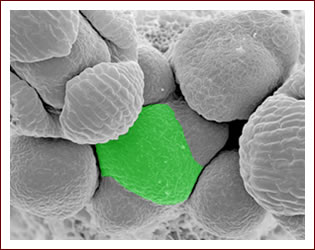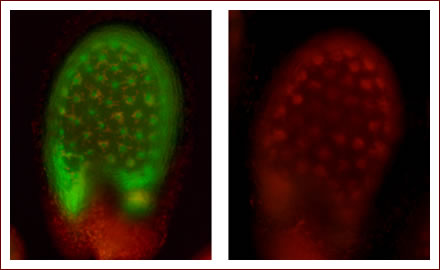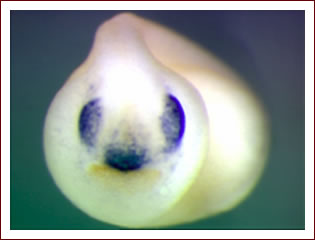Special Research Groups
Developmental Morphology Research Group
Development of above-ground parts in flowering plants is highly dependent on a tissue called the shoot meristem, a group of highly dividing cells at the tip of the stem. The shoot meristem maintains pluripotent stem cells in the center and produces cells that give rise to various types of shoot organs, such as leaves, stems, or floral organs. The aim of our group is to understand the molecular mechanisms that regulate shoot meristem formation and organ production.

Fig. The inflorescence shoot apex of Arabidopsis thaliana. The shoot meristem (colored green) produces flower primordia from the periphery.
Plant Reproductive Genetics Research Group
Our research goal is to understand the elaborate mechanism of sexual reproduction in flowering plants. In particular, we are interested in the epigenetic mechanism of genomic imprinting that results in maternal- and paternal- specific gene expression in the endosperm. The balanced action of these parental genes is thought to be a prerequisite for successful reproduction. We have been studying the epigenetic regulation of imprinted genes in Arabidopsis. We have also been investigating a reproductive barrier found in hybrid endosperm derived from crosses between cultivated rice and wild rice, in relation to genomic imprinting.

Fig. Imprinted gene expression of pFWA::FWA-GFP in Arabidopsis endosperm.
GFP fluorescence (green) is observed when the pFWA::FWA-GFP gene is inherited from the female (left), whereas the gene inherited from the male is silent (right). The red color represents chlorophyll autofluorescence.
Developmental Genomics Research Group
Recent remarkable progress of genome sequencing projects has revolutionized biology in the new millennium. Whole-genome sequencing has been completed or is ongoing for a great variety of higher eukaryotes, including human, frog, amphioxus, and sea urchin. Analysis of conserved and species-specific gene regulatory mechanisms based on these genome sequence data is one of the most important research areas in the post-genomic era. To understand the relationships between genome evolution and morphology, we are investigating the roles of conserved and non-conserved cis-regulatory elements in Xenopus, and their regulation, using high-throughput transgenesis technology.

Fig. Frontal view of a transgenic Xenopus tailbud embryo expressing GFP under the FoxE3 promoter. GFP expression (blue staining) is observed in the presumptive lens and oral ectoderm.
